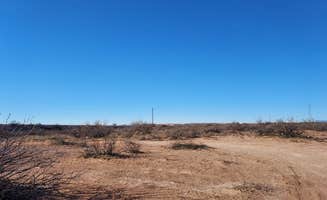Dispersed camping opportunities near Columbus, New Mexico provide free overnight accommodations in a stark Chihuahuan Desert setting dominated by creosote bush and mesquite. The region sits at elevations between 4,000-5,000 feet, creating significant temperature fluctuations between day and night regardless of season. Winter nights can drop below freezing while summer temperatures regularly exceed 100°F from May through September.
What to do
Explore remote desert peaks: The Desert Peaks National Monument offers hiking opportunities where visitors can experience rugged desert terrain. A camper at Gap Tank dispersed camping reported: "I've camped here twice in my truck bed—once in 2017 when I climbed Mt. Riley and once in 2020."
Wildlife observation: The remote desert areas provide opportunities to spot desert animals in their natural habitat. One visitor to Gap Tank noted: "No javelinas this time, just a jackrabbit. Gap Tank was dry but nearby Mesquite Tank had water and even a little ice on the edges."
Stargazing: The remote nature of dispersed camping sites creates excellent conditions for night sky viewing with minimal light pollution. A recent visitor to Dispersed Camping off Corralitos Rd on I-10 mentioned: "For a stop to rest and eat, it worked perfectly. There is a gas station nearby, but the area is dispersed, so there are no services."
What campers like
Dark night skies: The remote location of dispersed campsites creates opportunities for exceptional stargazing. A camper at Gap Tank reported: "The sky was dark at night and we couldn't see any electric lights. Kind of cool so close yet so far from El Paso."
Cell service availability: Despite the remote locations, some dispersed camping areas maintain usable cell reception. A camper at Corralitos Rd noted: "Verizon service was good."
Winter camping conditions: The cooler months provide more comfortable camping conditions in this desert environment. One visitor in January stated: "I tent camped at Gap Tank again in January 2025. Awesome time again. It was actually cold then."
What you should know
Limited facilities: Free camping near Columbus, New Mexico provides no amenities whatsoever. A reviewer at South Gage Dispersed Camping confirmed: "Only a couple miles off of 10, easy to get to in any vehicle. The surrounding mountains are beautiful but I'm not sure if this is a dispersed camping spot, there is a quarry and it's loud, it's very dusty."
Questionable camping areas: Some locations advertised as dispersed camping may not be designated for overnight stays. A visitor to South Gage reported: "I'm not staying because of the noise and to be honest I'm not sure camping overnight is allowed here."
Environmental considerations: Some dispersed areas may have significant environmental concerns. A visitor to Corralitos Rd reported: "This area was nice to stop for the night because I was getting tired. Lots of highway noise, and the area is a bit trashy."
Tips for camping with families
Safety planning: The remote nature of these dispersed camping locations requires extra preparation when traveling with children. A camper at Gap Tank noted: "Close to Mexican border but I didn't have any problems."
Extremely primitive conditions: Families should prepare for complete self-sufficiency in harsh desert conditions. A reviewer described Gap Tank as: "Very few people out there. Very primitive. No campground. Little to no shade."
Alternative locations: For families seeking dispersed camping with more amenities, consider areas east of Las Cruces instead. One camper suggested: "If you want a free site that you can spend a few days at, there are some great dispersed campgrounds on the east side of Las Cruces. They have hiking trails nearby at the Orange Mountains."
Tips from RVers
Access limitations: Not all dispersed camping areas can accommodate larger vehicles. A Gap Tank visitor warned: "Probably not conducive to RVs because difficult to pull off county road."
Highway proximity sites: Some dispersed camping areas offer easier access for larger vehicles but come with significant drawbacks. A visitor noted Corralitos Rd is: "Large enough for any kind of camper (RV, Trailers, ect). You could also tent camp if you wanted."
No-cost overnight options: The dispersed camping areas around Columbus provide free alternatives to paid campgrounds for travelers on a budget. A visitor stated: "This area is about 20 minutes west of Las Cruces. It's directly off the highway and is a gravel/dirt area. There aren't really any sites, more just areas to pull a vehicle through."



